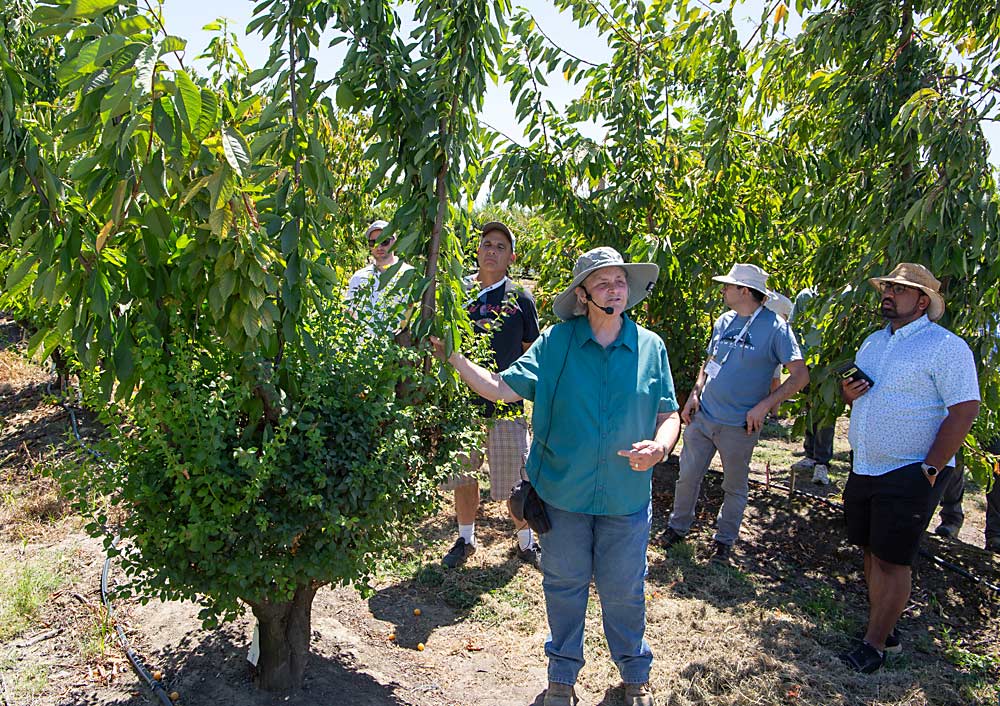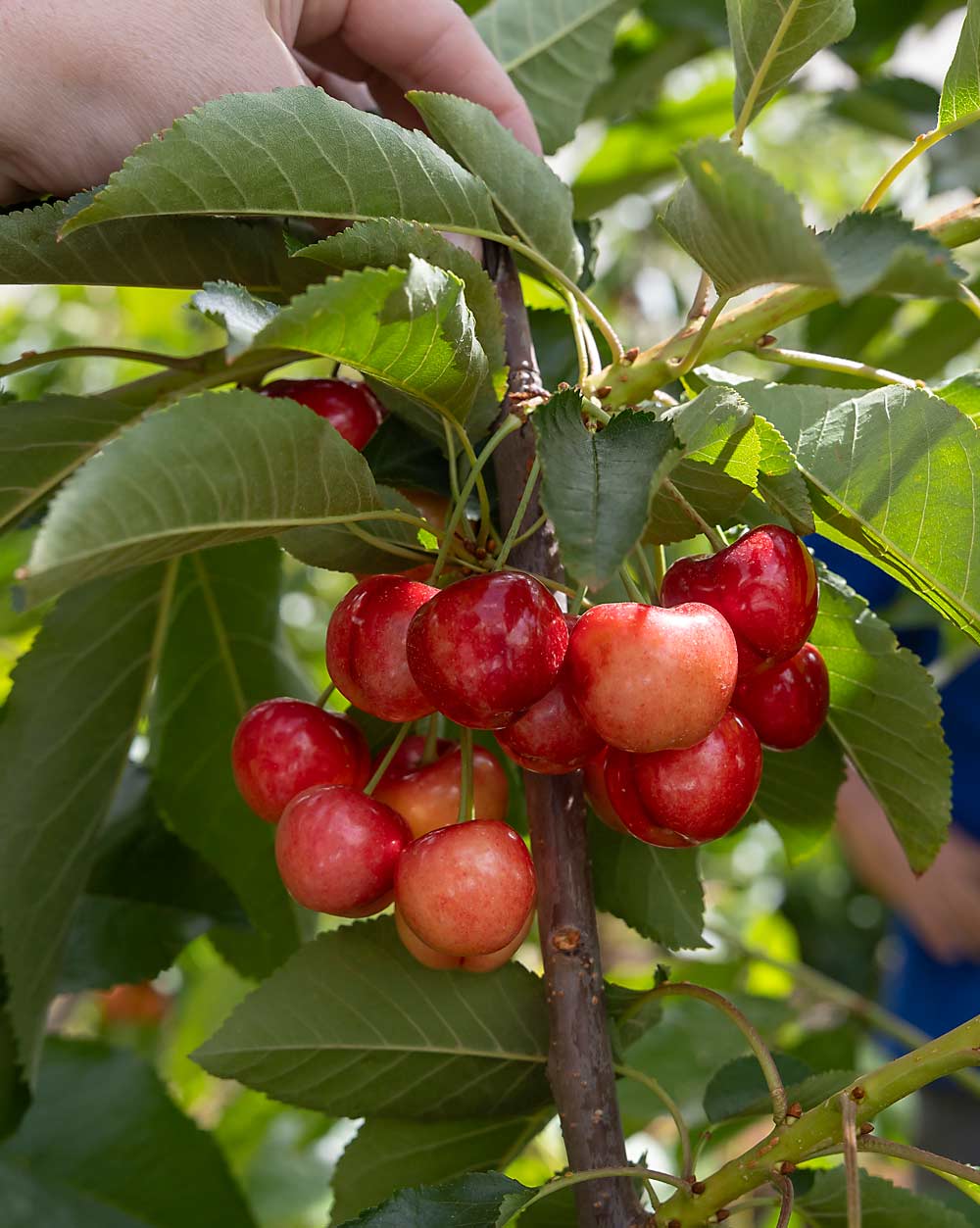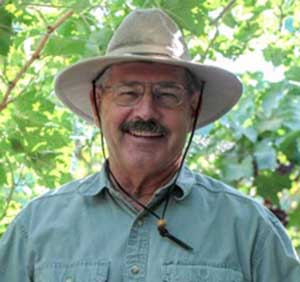—story by Ross Courtney
—photos by Ross Courtney and Kate Prengaman

Leith Gardner would like to remind people that cherries aren’t guaranteed to grow well in warm climates just because they are “low chill.”
“There are other factors than just cold hours,” said Gardner, owner of Zaiger Genetics of Modesto, California, known for breeding early varieties of stone fruit, sweet cherries and apples.
Fruit production companies throughout the world are planting cherries in warmer regions, aiming to fill the market year-round and capitalize on harvest windows. That’s not new, but Gardner has been fielding calls in recent years from Brazil, Costa Rica, India and other tropical or near-tropical climates.
Chill hours are the cumulative amount of cool weather trees need for adequate budbreak and flowering. If cherries don’t get enough, flowers may not fully form, trees bloom sporadically and fruit sets poorly. Varieties differ in the amount of chill they require.
Lower chill requirements are controlled by different genes than those that control other traits breeders target, such as early bloom and early harvest, and how well a new cultivar performs in a given climate is a mix of all those complex genetic factors, and more.
Zaiger and other California breeders seek varieties that ripen earlier and allow shippers to have the market to themselves for several weeks before Washington’s crop arrives. Producers in South Africa, Chile, Mexico and Australia use a similar playbook and are looking to California-bred varieties such as Zaiger’s for more options.
Peaches, nectarines and almonds generally follow chill requirement “rules” such that lower chill, early bloom and fruit set traits coincide, Gardner said. With cherries, there is more to the equation.
“Cherries and apricots don’t necessarily follow those rules,” she said.
She has cherries in her Modesto blocks that bloom on Feb. 20, by all accounts early, but won’t set fruit when they are planted farther south. She also has varieties that bloom in Modesto around the same time as the traditional Bing, but they produce just fine in Bakersfield, one of the hottest, earliest parts of the state.
Sunlight may be part of the equation. Growers in California’s warmer Central Valley region use netting — sometimes black — in the winter to protect cherry tree bark from direct sun, trying to lengthen dormancy or cut down on spring heat units, another factor affecting when a tree breaks dormancy. In their region, where growers once counted on fog to protect them from early break, they don’t want the sunshine to “trick” the trees into waking up too early. When they are ready, growers artificially break dormancy with plant growth regulators such as Dormex (hydrogen cyanamide).
Rootstocks have their own chill requirements, adding another factor to the equation.
Considering all of those factors, the term low chill is only one clue about a cherry’s promise in a given climate.
“Chilling hours is an indication that it’s possible to try,” she said.
Chris Owens, head plant breeder at Bloom Fresh International in California, has fielded inquiries about cherries for areas with no chill at all.
“These aren’t zero-chill cherries,” Owens said.
He has noticed increasing interest in Peru as a new growing region, specifically coastal areas that have little, if any, winter chilling. Grapes and blueberries are making their way to such parts of the world, so it’s natural for entrepreneurs to ask about cherries, too, he said.
As for the other factors Gardner mentions, they are harder to quantify, so the discussion usually starts with chilling requirements, Owens said.
Sierra Gold Nurseries in Yuba City, California, have not fielded sales calls from growers eyeing Mexico and Peru, but they have talked about those regions, said CEO Reid Robinson.
If the company needs to teach any lessons, it’s usually about rootstocks, Robinson said. Most customers know what cultivar they want, but rootstocks affect chill needs, as well as heat tolerance and precocity, he said.
“That’s where we see more gaps of education,” he said.

Research gaps
Researchers are still pinning down the connection between the need for ample chill and the spring heat units required for budbreak, said Matt Whiting, a fruit physiologist for Washington State University. The industry assumes there is one: If a tree requires less chill, it usually requires fewer heat units to flower.
But things don’t always line up perfectly, Whiting said.
Growers in cooler regions shouldn’t automatically overlook low-chill cultivars, he said. Those trees may not bloom as early as they’d think.
This common perception of chill also does not account for the differences in tree tissue temperature and air temperature. Tree bark, especially in a crotch exposed to the sun, will heat up even on a cold day, he said.
The other topic that could use more research is the connection between bloom timing and harvest timing, said Per McCord, Washington State University cherry breeder.
“They are related but not in lockstep with each other,” he said.
For example, Regina blooms after Sweetheart but ripens before.
In his work in Washington, with chill aplenty, McCord rarely selects for chill hours. He focuses on bloom timing for frost protection and harvest timing for market windows. And he often wants later varieties.
“Is that because we need more chill or more spring heat units, or both?” he said.
Whiting, McCord and their colleagues in Washington, Oregon and California have proposals out to research funders to support further exploration of these dynamics, he said.
Cherry timing, whether for bloom or harvest, depends on a lot of factors, McCord said. There is even evidence that individual branches and buds can have their own behavior.
“Nobody really talks about those other things, they just talk about chill,” he said.
Chilling requirements, bloom time and harvest timing are correlated, said Owens of Bloom Fresh, but those characteristics can be separated by breeders.
In fact, Bloom Fresh gets occasional requests for cherries with low chill requirements but later bloom and maturity times, because growers want to plant in warm areas but still stretch out their season. New regions of Australia are an example, he said.
“It’s a little tough for us to fulfill that because we haven’t been selecting for it,” Owens said. But that doesn’t mean he can’t.
“In my opinion, there is variation for just about everything,” he said. •








Leave A Comment